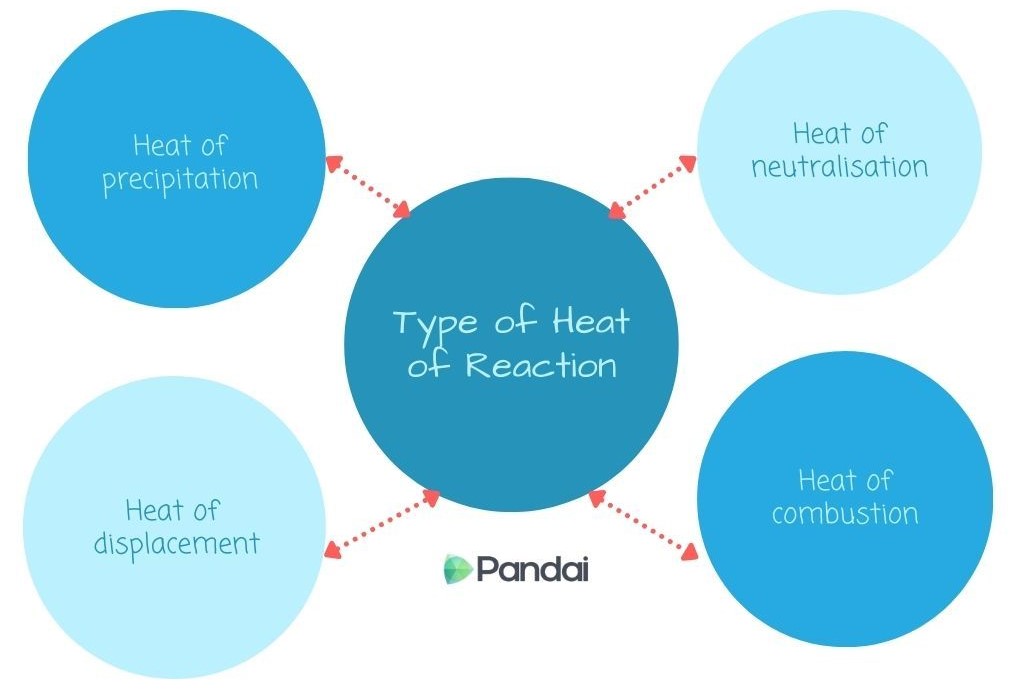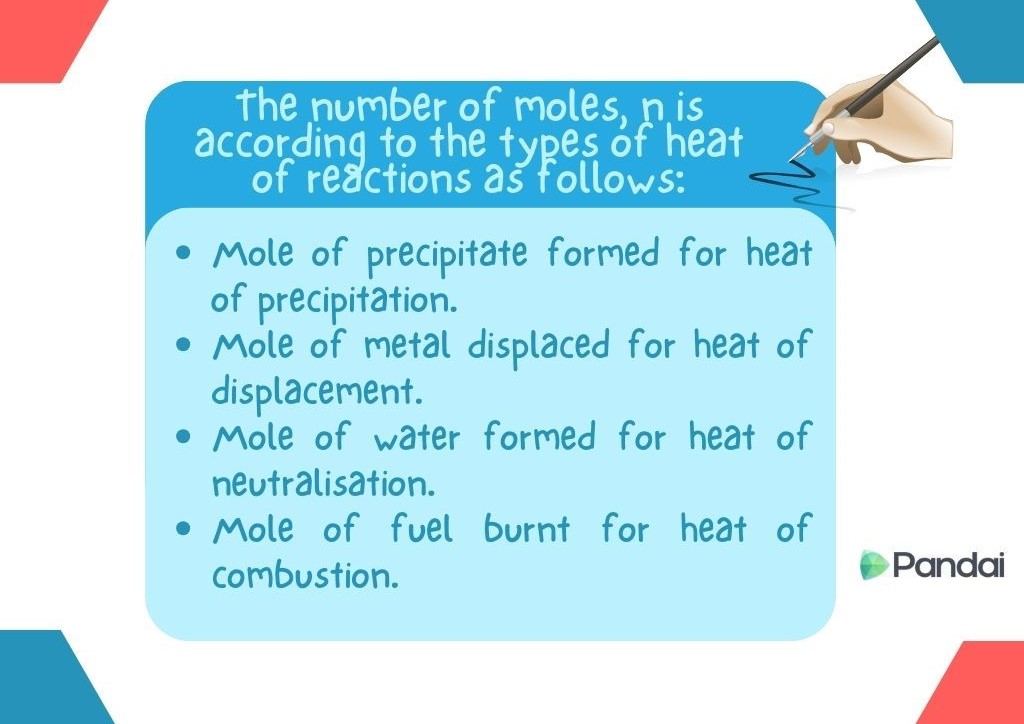| |
|
|
| |
 |
| |
| Way to Determine Heat of Reaction |
- The heat of reaction can be determined through experiments by establishing the temperature change when the reaction occurs.
- The value of temperature change obtained is used to calculate heat of reaction.
|
|
| |
| General Steps to Calculate Heat of Reactions |
| Step 1 |
Determine the number of moles of the reactants and products formed, n mole. |
| Step 2 |
Calculate the heat change in the reaction: 𝑄=𝑚𝑐𝜃 \(Q = mc\theta\).
|
| Step 3 |
Calculate the heat change for 1 mole of reactant or 1 mole of product formed in proportion. |
| Step 4 |
State the heat of reaction, \(\Delta \text{H}\) with +/- signs and the correct units: ΔH=+/−kJ mol−1 \(\Delta \text{H}=+/- \text{kJ mol}^{-1}\). |
|
| |
| Formula to Calculate Heat Change |
| \(Q=mc\theta \\ \,\\\text{Where by,} \\ \,\\ \begin{aligned} m &= \text{Mass of reaction mixture}\\ c &= \text{Specific heat capacity}\\ \theta &= \text{Change of temperature}\\ \end{aligned}\) |
|
| |
 |
| |
| Assumptions Made During Calculations |
- Most chemical reactions carried out to determine the heat of reaction involve aqueous solutions.
- Some assumptions are made during calculations:
- The density of any aqueous solution is the same as the density of water, \(1 \text{ g cm}^{-3}\).
- The specific heat capacity of any aqueous solution is equal to the specific heat capacity of water, which is \(4.2 \text{ J g}^{ -1 \,\text{ o}} \text{C}^{-1}\).
- No heat is lost to the surroundings.
- No heat is absorbed by the apparatus of the experiment.
|
|
| |
| Definition of Heat of Precipitation |
- The heat change when 1 mole of precipitate is formed from their ions in an aqueous solution.
|
|
| |
| Example of Calculation of Heat Precipitation |
|
Lead(II) nitrate, \(Pb(NO_3)_2\) and sodium sulphate, \(Na_2SO_4\) of certain volume and concentration, is mixed.
\(10\,000\,J\) of heat is released.
The change in temperature is 7°C.
What is the volume of the lead(II) nitrate, \(Pb(NO_3)_2\) solution?
[Specific heat capacity = \(\text{4.2 J g}^{-1}\,^\circ \text{C}^{-1}\); Density of solution = \(\text{1.0 g cm}^{-3}\)]
|
|
Answer: \(\text{340 cm}^3\)
\(\begin{aligned} m&=\dfrac{heat}{c \theta}\\ &=\dfrac{10 000 J}{\text{4.2 J g}^{-1}\,^\circ \text{C}^{-1} \times 7^\circ \text{C}}\\ &=\text{340 g} \end{aligned}\)
\(Density = \dfrac{Mass}{Volume}\\ \,\\ \begin{aligned} Volume&=\dfrac{Mass}{Density}\\ &=\dfrac{\text{340 g} }{\text{1.0 g cm}^{-3}}\\ &=\text{340 cm}^3 \end{aligned}\)
|
|
| |
| Definition of Heat of Displacement |
- The heat change when 1 mole of a metal is displaced from its salt solution by a more electropositive metal.
- The more electropositive metal can displace a less electropositive metal from its salt solution.
|
|
| |
| Example of Calculation of Heat of Displacement |
|
The ionic equation shows the displacement of lead from its salt solution.
\(Al(s)+Pb^{2+}(aq)\rightarrow Al^{3+}(aq)+Pb(s)\\ \Delta H=-150.7\,kJ\,mol^{-1}\)
The reaction displaced 20.7 g of lead solid.
Calculate the amount of heat released from the reaction.
[Relative atomic mass: \(Pb=207\)]
|
|
Answer: \(\text{15 070 J}\)
\(\text{Number of mole Pb}\\ =\dfrac{\text{Mass of Pb}}{\text{Molar mass of Pb}}\\ \,\\=\dfrac{20.7\,g}{207\,g\,mol^{-1}}\\ \,\\=0.1\,mol\)
\(\begin{aligned} \dfrac{\text{Heat released}}{0.1\,mol}&=\dfrac{150\,700\,J}{1\,mol} \end{aligned}\)
\(\text{Heat released}\\ =\dfrac{150\,700\,J}{1\,mol} \times 0.1\,mol\\ \,\\=\text{15 070 J}\)
|
|
| |
| Definition of Heat of Neutralisation |
- The heat change when 1 mole of water is formed from the reaction between an acid and an alkali.
|
|
| |
| Factors Affecting Heat of Neutralisation |
| Strength of Acid and Base |
- The strength of the acid and base affects the amount of heat released from the reaction.
- The heat released for the neutralisation of strong acid and strong base is the highest, in comparison to the neutralisation of weak acid and weak base.
- Neutralisation reactions can occur between acids and alkalis of different strengths as follows:
- Strong acid and strong alkali.
- Weak acid and strong alkali.
- Wtrong acid and weak alkali.
- Weak acid and weak alkali.
- The theoretical value of the heat of neutralisation between a strong acid and a strong alkali is \(-57 \text{ kJ mol}^{−1}\) seperti di bawah:
| Example |
Heat of neutralisation, \(\Delta \text{H}\) (\(\text{ kJ mol}^{−1}\)) |
| Strong acid + Strong alkali → Salt + Water |
-57 |
| Weak acid + Strong alkali → Salt + Water |
-55 |
| Strong acid + Weak alkali → Salt + Water |
-52 |
| Weak acid + Weak alkali → Salt + Water |
-50 |
- Note that there is an influence of acid and alkali strengths over the heat of neutralisation.
- The value of the heat of neutralisation is lower when weak acids or weak alkalis are used.
| Explanation on the Lower Value of the Heat of Neutralisation When Weak Acids or Weak Alkalis are Used |
| Weak acids or weak alkalis ionise partially in water and some remain as molecules. |
| \(\downarrow\) |
| Some of the heat released during neutralisation is absorbed and used to completely ionise the weak acid or weak alkali in water. |
| \(\downarrow\) |
| Therefore, the heat released is lower. |
- The heat of neutralisation between weak acids and weak alkalis is the lowest:
- More heat energy is needed to completely ionise both weak acids and weak alkalis.
- Therefore, hydrogen ions, \( H^+\) and hydroxide ions, \(OH^−\) produced can completely react to form 1 mole of water.
|
- Peneutralan lengkap antara asid diprotik kuat dan alkali kuat menghasilkan dua kali ganda kuantiti haba berbanding asid monoprotik kuat.
| Comparison |
| Strong Monoprotic Acid + Strong Alkali |
Strong Diprotic Acid + Strong Alkali |
| \(HCl + NaOH \rightarrow NaCl + H_2O\\ \Delta H = -57 \text{ kJ mol}^{-1}\) |
\(H_2SO_4 + 2NaOH \rightarrow Na_2SO_4 + 2H_2O\\ \Delta H = -114 \text{ kJ mol}^{-1}\) |
- One mole of a strong diprotic acid such as sulphuric acid, \(H_2SO_4\) ionises in water to produce two moles of hydrogen ions, \( H^+\).
- Two moles of hydrogen ions, \( H^+\) will produce two moles of water, \(H_2O\) when they react with two moles of hydroxide ions, \(OH^−\).
- 114 kJ heat is released because two moles of water are formed.
- The heat of neutralisation of sulphuric acid, \(H_2SO_4\) with sodium hydroxide, \(NaOH\) solution is still the same, which is -57 kJ, because the meaning of the heat of neutralisation is the heat released for the formation of one mole of water.
- Using monoprotic acids such as hydrochloric acid, \(HCl\) or nitric acid, \(HNO_3\) with a strong alkali, such as sodium hydroxide, \(NaOH\) or potassium hydroxide, \(KOH\), will produce one mole of water.
| Example |
|
Which of the following would have the highest amount of heat released from the reaction?
| (A) |
|
\(CH_3COOH(aq) +NaOH(aq)\) |
| |
|
|
| (B) |
|
\(HCl (aq)+ KOH(aq)\) |
| |
|
|
| (C) |
|
\(HCl (aq)+ NH_4\,^+(aq)+OH\,^-(aq)\) |
| |
|
|
| (D) |
|
\(CH_3COOH(aq) +NH_4\,^+(aq)+OH\,^-(aq)\) |
|
|
Answer: B
Hydrochloric acid, \(HCl\) is a strong acid and potassium hydroxide, \(KOH\) is a strong base.
|
|
|
| |
| Definition of Heat of Combustion |
|
The heat change when 1 mole of a substance is completely burnt in excess oxygen, \(O_2\).
|
|
| |
| Contoh |
|
When \(\text{5 g}\) of fuel \(X\) is burnt in excess oxygen, it raised the temperature of \(\text{250 cm}^3\) water by \(\text{40 }^OC\).
Calculate the heat of combustion of the reaction.
[Specific heat capacity of water= \(4.2 \, J \, g^{-1}\,^OC^{-1}\), Density of water= \(1.0 \,g\,cm^{-3}\); Molar mass \(X= \text{20 g mol}^{-1}\)]
|
|
Answer: \(\text{168 kJ mol}^{-1}\)
\(\text{Heat change}\\ =mc\theta\\ = 250\,g \times 4.2\,J\,g^{-1}\,^OC^{-1} \times 40^OC\\ =42\,000\,J.\)
\(\text{Number of mole X}\\ =\dfrac{\text{Mass}}{\text{Molar mass}}\\ =\dfrac{\text{5 g}}{\text{20 g mol}^{-1}}\\ =\text{ 0.25 mol.}\)
\( \text{Heat of combustion}\\=\dfrac{\text{Heat change}}{\text{Number of mole}}\\ =\dfrac{\text{42 000 J}}{\text{0.25 mol}}\\ = \text{168 000 J mol}^{-1}\\ =\text{168 kJ mol}^{-1} \)
|
|
| |
| Complete Combustion of Alcohol |
- Alcohol molecules consist of carbon atom, C, hydrogen atom, H and oxygen atom, O.
- Complete combustion of alcohols produces carbon dioxide, \(CO_2\) and water, \(H_2O\).
- Combustion of alcohol also releases energy, which is an exothermic reaction.
- As the number of carbon atoms per alcohol molecule increases, the combustion of alcohol produces more carbon dioxide and water molecules.
- Therefore, more heat is released.
- The increment in the heat of combustion between successive members of alcohols is almost the same.
- This is because each member differs from the following member with one \(CH_2\) group.
|
|
| |